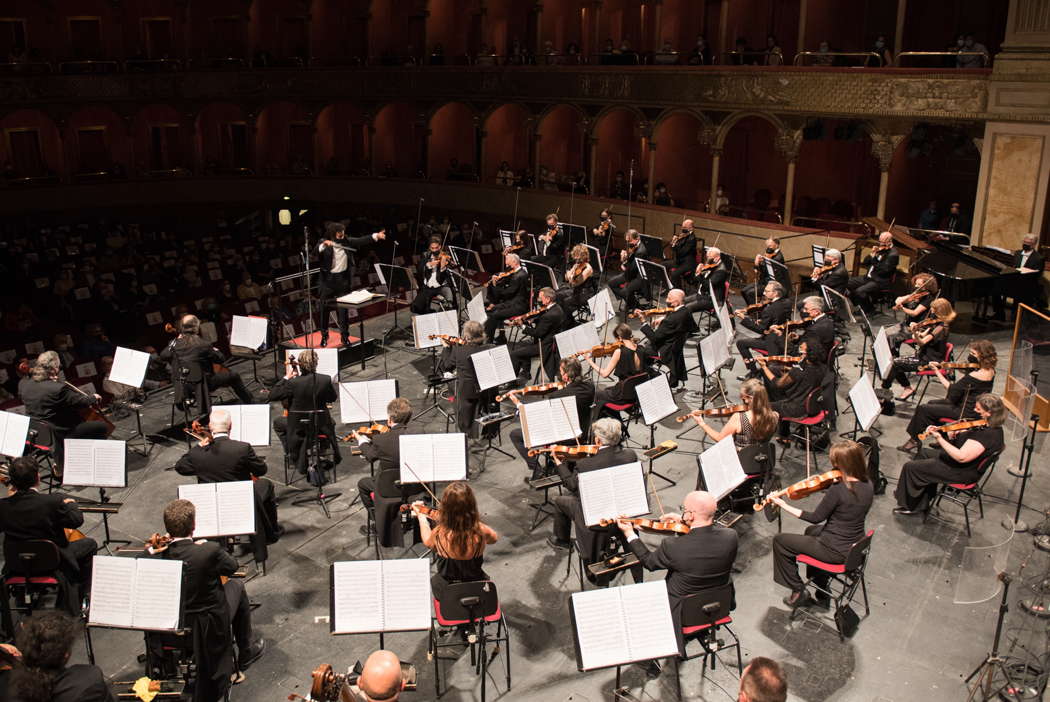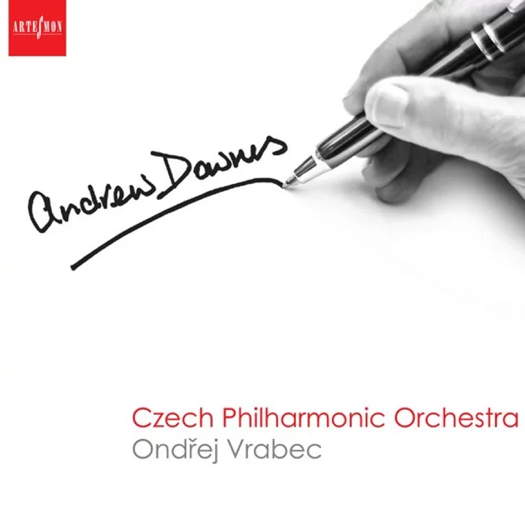 VIDEO INTERVIEW: Ona Jarmalavičiūtė talks to American choral conductor Donald Nally, director of The Crossing, in this fascinating, illustrated, one hour programme.
VIDEO INTERVIEW: Ona Jarmalavičiūtė talks to American choral conductor Donald Nally, director of The Crossing, in this fascinating, illustrated, one hour programme.
Chaos Instead of Music?
GIUSEPPE PENNISI listens to Wagner and Shostakovich in a triumphant concert by Alejo Pérez and the Teatro dell'Opera di Roma Orchestra
On 29 May 2021, the last concert of the series 'great conductors' was held at Teatro dell'Opera di Roma. The theatre was sold out in the five hundred places available - out of a thousand and five hundred seats - authorized by the 'anti-COVID' rules. The concert was conducted by Alejo Pérez who, at the Teatro dell'Opera in Rome, has conducted, in recent seasons, Rossini's Cenerentola, Shostakovich's The Nose, Berg's Lulu and Prokofiev's The Fiery Angel. It included two very different pieces. The first was the extrovert overture to Rienzi by the twenty-eight-year-old revolutionary Richard Wagner. The second was the introverted Symphony No 5 in D minor by Dmitri Shostakovich who, a year earlier, had been banned from official Soviet music culture.

A scene from the 29 May 2021 concert by Alejo Pérez and the Teatro dell'Opera di Roma orchestra. Photo © 2021 Fabrizio Sansoni
Alejo Pérez is an Argentinian conductor. After graduating as a pianist, composer and conductor, he earned two postgraduate degrees in conducting with Péter Eötvös, Helmuth Rilling and Sir Colin Davis. He conducts in the most important theatres in Europe and the world such as the Vienna Philharmonic, Semperoper Dresden, Lyric Opera Chicago, the Salzburg Festival, Real de Madrid, Teatro Colón and the opera houses of Rome, Lyon and Tokyo, among others. He composed and conducted the opera Tenebrae on behalf of the experimental centre of Colón. He has been director of the Bicentennial Youth Orchestra since his inception in 2010. He is currently music director of the Vlaanderen Opera in Belgium.

Alejo Pérez conducting the Teatro dell'Opera di Roma orchestra on 29 May 2021. Photo © 2021 Fabrizio Sansoni
Wagner's Rienzi is an imposing work whose full duration exceeds six hours, so much so that in Dresden, after its debut, it was decided to present it in two evenings - the first dedicated to the political rise of the protagonist, the second to his downfall. The story is Rienzi's struggle against the oligarchies that dominate Rome, while the Pope is in Avignon. After his apparent victory and the creation of a municipal republic in which the tribune rules out of popular will, the same social groups that had brought him to government, cradled by the high clergy and the aristocracy, revolt against him. From a musical point of view, the models are Gaspare Spontini - especially Fernand Cortez - and Giacomo Meyerbeer - especially Robert le Diable - but the 'closed numbers' are largely exceeded by moments anticipating the declamations and ariosi that will be increasingly characteristic of Wagner's subsequent production. I saw and heard two good productions: the first by Eve Queller in Washington in 1982 and the second conducted by Stefan Soltesz at the Teatro dell'Opera in Rome in 2013. They had cuts, especially in the ballet. For the unabridged edition, you have to listen to the 1976 recording with the Dresden opera ensemble.
The overture is impressive, as is the rest of the work. It contains the main themes, especially that of 'the prayer to God to help the protagonist to govern well' which flows into a great aria of the fifth act. Pérez and the Teatro dell'Opera orchestra gave an overwhelming reading, especially in the dialogue between strings, brass and percussion.
Shostakovich's Symphony No 5 in D minor was written between April and July 1937 - a troubled period in the composer's life. In 1936, the debut of his opera Lady Macbeth of the Mtsensk District took place. A month later, Pravda crushed Shostakovich's work in a famous article - anonymous, but attributable to or at least referring to Stalin himself, who was in the central box at the debut - entitled Chaos instead of Music. It was clear that Shostakovich's compositions were not well seen by the regime. This became apparent when, after the publication of the article in Pravda, Lev Knipper, Boris Asafiev and Ivan Dzerzhinsky advised the composer to 'go back' on the right path: this meant simplification of his future works and the adaptation of these to the models underlying 'socialist realism'. Shostakovich did not seem to have any other option, especially since at that time many of his friends and colleagues were arrested and mysteriously disappeared. With the fifth symphony, Shostakovich attempted to rehabilitate himself before the communist party. It was a great success, and it is said to have received an ovation that lasted half an hour. The symphony lasts about forty-five minutes, and is divided into four movements.

A scene from the 29 May 2021 concert by Alejo Pérez and the Teatro dell'Opera di Roma orchestra. Photo © 2021 Fabrizio Sansoni
It begins with a Moderato movement. Shostakovich vents his compositional skills through the construction of the climax from the different sections of the movement; it grows in intensity through the very narrow development of thematic ideas until it reaches the expressive peak with an immense orchestral explosion. Then, slowly, it folds in on itself until it turns into a final lyrical resumption of the themes of the beginning. Pérez and the orchestra cleverly showed the alternate sensations of serenity and restlessness expressed by the strings and then taken over by the woodwind and brass, and by solo horns, flutes and clarinets. The initial climate of serenity ends with the entry of the piano and horns, followed by trumpets and woodwind in a crescendo by the entire orchestra - a march that can be understood as the Russian composer's mockery of the Stalinist regime. At the end of the march, a new orchestral crescendo begins. With the timpani blows, the movement reaches the peak of the whole symphony's tension. After this violent section, the music returns to lower tones, with dialogue between the various woodwind instruments. The entrance of the horns is a prelude to the solo flute, and finally to the intervention of the first violin. The movement ends with a particular chromatic scale, repeated three times, entrusted to the celesta. In this arduous movement, the Teatro dell'Opera di Roma orchestra has, once again, proved to be one of the excellences of Italian musical theatre.
The second movement (Allegretto) is an energetic Mahler-inspired waltz; the main theme derives from a germination of the melodic lines assigned to the wind in the first movement's large climax. The movement consists of the repetition of two themes, entrusted to the various sections of the orchestra. The third movement is a largo in which beautiful melodies are played by strings and solo winds, in turn. The closure of the movement, entrusted to harp and celeste in a magical and delicate climate, seems to recall the first movement's surreal ending.
In the fourth movement (Allegro ma non troppo), the beginning is a musical joke of the whole orchestra; opening with brass and percussion, in a march that subsequently involves the whole orchestra. A long dialogue between strings, horns and flutes follows, culminating in the entrance of the harp. The entire orchestra then enters, with a crescendo, constant until the end. There it reaches the height of tension: after the final explosion of the entire orchestra, the symphony ends with a solo of timpani, percussion and brass (symbolizing the power of the regime), which overlaps with the incessant repetition of D major by the string section - the composer oppressed by the regime. Shostakovich wrote: 'this ending gives an optimistic response to the tragic moments we find in the earlier parts of the symphony'.

A scene from the 29 May 2021 concert by Alejo Pérez and the Teatro dell'Opera di Roma orchestra. Photo © 2021 Fabrizio Sansoni
Pérez and the orchestra handled the symphony perfectly, deserving of the ovations at the end of the concert.
Copyright © 2 June 2021
Giuseppe Pennisi,
Rome, Italy

MORE ARTICLES ABOUT CLASSICAL MUSIC IN ROME
MORE ARTICLES ABOUT ORCHESTRAL MUSIC




